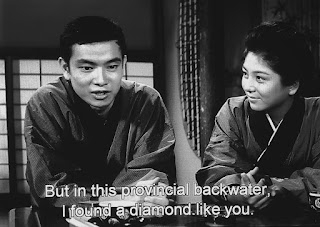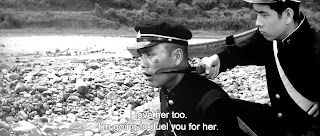New-Kid-in-Town Monogatari
(All images are details from iPhone photos taken of the film playing from the Arrow Blu-ray as included in the boxset Seijun Suzuki: The Early Years: Vol. 1: Seijun Rising: The Youth Movies.)
===
The Taishō period.
Akutarō [
The Bastard, maybe also
The Badboy, I don't know where to come down definitively in this translation conflict, 1963] was the nickname of Tōgo Konno (Ken Yamauchi) at his former secondary-school in Kobe, where he attended as the son of a widower with upper-middle-class means before the boy's mother pulled him out to enroll him in small-town Toyooka. The Public Morals Unit, comprised of his upper-classmen, don't take kindly to strangers in dandy
hakama...
It's easy to see how, in comparison to Suzuki's contemporaneous works,
The Bastard might be considered, and too happily so by dilettante critics, as a prestige picture in the sense of Ford's
The Informer [1935] or Naruse's
Floating Clouds [
Ukigumo, 1955] — both films I love, but they're well-rounded in romantic-vision and certain production values and non-angular pacings on the way to denouements (also see Mizoguchi's
Sanshō-dayū [
Sanshō the Steward, 1954]) that institutional awards-services might recognize them over not only the termite entries of the respective œuvres but the more stylistically flamboyant popular pictures that still draw attention in retrospectives and reissues today. That's fine. Life could be worse than experiencing masterpieces like
The Informer,
Floating Clouds,
Sanshō-dayū, or maybe not a masterpiece but stark cinema,
The Bastard. Why don't I say this is not a Suzuki masterpiece? I don't know — why haven't I said any of the films that precede it are? Some are better than this; many of those I still haven't seen (have you looked at Suzuki's filmography?); this movie's just different from what came before, and as such, and in and of itself, it's fascinating. Blob Saget was on Seth Meyers last night and he said that his show should be eventually called
Fullest House when his ashes rest in an urn on a sill.
If you haven't yet seen
The Bastard know that the biggest conceit involves August Strindberg's 1879 novel
The Red Room [
Röda rummet]. I've never read it, and didn't even know except in a few forgotten whisperings that Strindberg wrote novels — I figure this is something like how most people into Dostoevsky haven't read
Poor Folk [
Bednye lyudi, 1846] — but I paste this excerpt off Wikipedia from the American critic John Albert Macy in 1922:
"[Strindberg] writes of [his characters' — two young critics'] unconscious inhumanity and blindness in a way that reveals his own clearness of vision and fundamental humanity. The laughter of a somber humorist has in it a tenderness unknown to merry natures." Make of that what you will.
I like the irony in the film title quite a more than a bit: with regard to Strindberg in his time of play, and with Suzuki's naming the picture
The Bastard, or
The Badboy, as both represent only ironical side-offerings to the straight denomination. Tōgo's a good-seed by any standard; in typical Japanese social critique of the era, it's truly the oppressors surrounding him that will drive him to pull daggers, abscond in spit — both tough attitudes. He's another drifter-savior in the Suzuki work, here of course in the guise of the transfer-student, fighting a de facto student-gestapo — the extreme manifestation in cinema of the dreams of the scenarists and Suzuki's own perceptions. The picture ends like something in a Satyajit Ray film, something from his Apu Trilogy.
In the essay that comes with the 60-page book in this Arrow boxset, writer Jasper Sharp quotes something to the effect by Shigehiko Hasumi that here everything came together for Suzuki for the first time: the actors, assistant-directors, production-designer, the cinematographer: — they made a prestige picture. As
Variety would say: All tech specs primo. But who cares except season-passing 90-year-olds in the faintest of rushes to that last 90-min of distracted distraction, padded heeled, unaware of imminent pulmonary terror?
•
===
Ankokugai no bijo [Underworld Beauty, 1958]
Fumi hazushita hara [Trampled Springtime, 1958]
Kage naki koe [Voice Without a Shadow, 1958]
"Jûsan-gô taihisen," yori: Sono gosôsha (w)o nerae ["Sidetrack No. Thirteen," or: Take Aim at That Police Van, 1960]
Kemono no nemuri [The Sleep of the Beast, 1960]
Subete ga kurutteru [Everything Goes Wrong, 1960]
Tōge (w)o wataru wakai kaze [Youthful Wind Crossing the Mountain Pass, 1961]
High-teen yakuza [Late-Teen Yakuza, 1962]
Yajû no seishun [Youth of the Beast, 1963]
Akutarō [The Bastard / The Badboy, 1963]
Akutarō-den: Warui hoshi no shita demo [Stories of Bastards: Even Under a Bad Star / Stories of Badboys: Even Under a Bad Star, 1965]
===















































